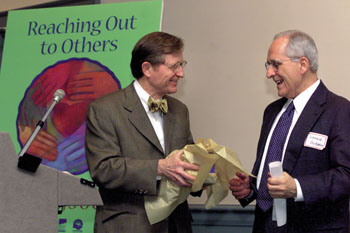
Chancellor E. Gordon Gee presents Dr. Lonnie Burnett, campaign chair, a present for chairing this year’s Community Giving Campaign. Raising more than $780,000, Vanderbilt employees helped break last year’s giving amount. (photo by Dana Johnson)
Donor organ shortage drives transplant options
It’s been nearly 50 years since the first organ transplant took place in the United States. Since then, medical professionals and patients alike have wondered what advancements lie ahead.
As survival rates, quality of life and overall satisfaction with the transplant process grew, the number of transplant procedures increased as well as the types of transplants performed.
But now in the 21st century, much of that is overshadowed by an unfortunate trend – the shortage of donor organs for transplantation.
More than 65,000 patients are waiting for organs. With less than 10,000 donations each year, the availability of organs has put the spotlight on health care professionals to come up with alternatives to keep patients alive.
In the area of cardiac and thoracic surgery, doctors are investigating several options including drug and implantable device trials.
One of the most promising therapies under exploration at Vanderbilt is the use of the LVAD as a “destination therapy” for some patients.
Traditionally, the LVAD (Left Ventricular Assist Device) is used for patients as a bridge to transplant. The implantable circulatory support system is used in cardiac transplant patients at risk of imminent death from left ventricular failure.
Now, the device is under study as destination therapy (device-dependent) or a bridge to recovery (transient support) for patients who are not transplant candidates. Ultimately, doctors see this device as a tangible alternative to transplant, which may serve as a permanent therapy for some.
“We are exploring alternatives,” said Dr. Richard N. Pierson III, associate professor of Cardiac and Thoracic Surgery. “We know that this device works as a bridge to transplant. Those who have been placed on the device become stabilized, get better and are mended. They stay on the LVAD for several months while waiting for transplant.
“What we want to know is – is this a good choice for people over the long haul?”
The Intrepid Trial, a study that will explore how long the device can be safely used, will help Vanderbilt answer those questions. The Medical Center will enroll five patients in the pilot phase with plans to increase the study to at least 20 patients.
Vanderbilt is one of five sites approved for the study.
Any patient who clinically qualifies for an LVAD will be enrolled.
The statistics for long-term survival includes 60 patients with LVADs for more than one year and 30 with an implanted device for more than two years.
“The system is very reliable,” Pierson said. “It just doesn’t break. It doesn’t develop mechanical problems and is easy to troubleshoot.”
Dr. Stacy Davis, assistant professor of Medicine and medical director of the Vanderbilt Heart Transplant Program, agrees that the LVAD looks like a promising therapy for heart failure patients. But she also emphasizes the importance of other therapies including drug trials, biventricular pacing and education.
“We are not just in the business of transplantation,” Davis said. “We look at the best options and focus on what is best for our heart failure patients. It could mean optimizing their medications, educating them about salt and fluid management, and utilizing an exercise program.
“We explore pharmaceutical trials, pacemaker trials and the role of the LVAD.”
Davis added that due to a limited donor supply and a 15 percent mortality rate for patients waiting for transplant, health care providers are exploring a multitude of options to keep heart failure patients alive.
“We must improve quality of life and evaluate cost effectiveness for therapies besides heart transplant,” she said. “But most importantly, we must show the survival advantage of any new treatment.”
Presently the LVAD is implanted within the muscle layers in the upper anterior wall of the abdomen. It is a mechanical device that pumps blood through the heart. Future plans call for a much smaller device that is completely implantable with a longer battery life.
Pierson said that the benefits of the Intrepid trial will enable Vanderbilt to offer cardiac support to more than the 2,000 to 3,000 patients who receive heart transplants a year. Potentially, this advancement will allow 20,000 to 30,000 people a year to receive supportive therapy – people who might not have been able to receive help until now.
“This is a new indication and the use of this device could have a substantial impact on the quality of life and the costs of cardiac health care,” Pierson said. “This device is less expensive than treating chronic heart failure and its management and costs are less than a transplant.”
The team of Vanderbilt physicians collaborating on the trial also include: Drs. Davis Drinkwater Jr., William S. Stoney Jr. Chair in Cardiac and Thoracic Surgery; Walter H. Merrill, professor of Cardiac and Thoracic Surgery; Don B. Chomsky, assistant professor of Medicine; and Javed Butler, assistant professor of Medicine; and heart transplant nursing coordinators Terri Donaldson and Renee Howser.













